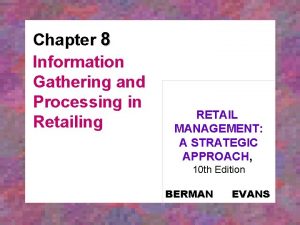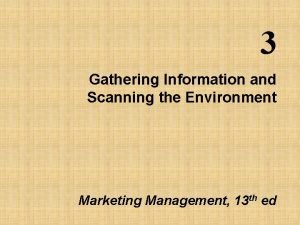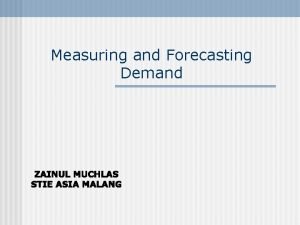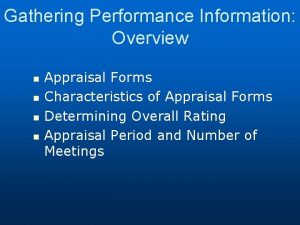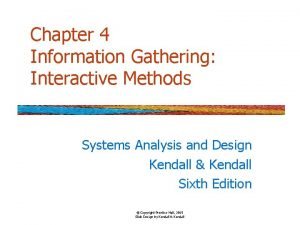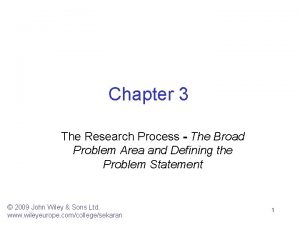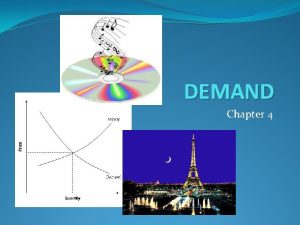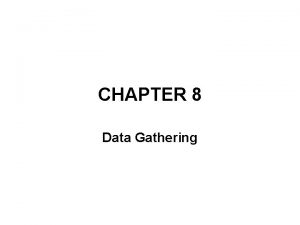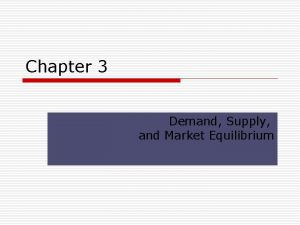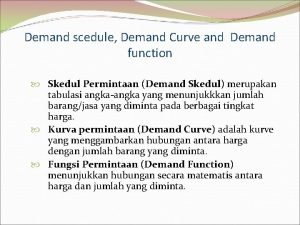CHAPTER 4 GATHERING INFORMATION AND MEASURING MARKET DEMAND


















- Slides: 18

CHAPTER 4 GATHERING INFORMATION AND MEASURING MARKET DEMAND

Important Topics of This Chapter Modern MIS. n Marketing research process. n Marketing decision support system(MDSS). n Forecasting and demand measurement. n Estimating current demand. n Estimating future demand. n

MODERN MARKETING INFORMATION SYSTEM n Marketing Information System: n n MIS consists of people, equipment, and procedures to gather, sort, analyze, evaluate, and distribute needed, timely, and accurate information to marketing decision makers. Internal Record System: » Order-to-payment cycle: n Orders and invoices (EDI), fax and e-mails » Sales information systems: n Sales force automation (SFA)

MODERN MARKETING INFORMATION SYSTEM n Marketing Intelligence System: » It is set of procedures and sources to obtain everyday information about marketing environment. Four steps to improve the quality: n n n Training/motivating the sales force Motivate distributors, retailers and customers to send necessary information Mystery Shoppers Syndicated research firms: – A. C. Nielsen Internal information centers: – Collect information. Customer advisory panels

MARKETING RESEARCH SYSTEM n Marketing Research: – Designing, collection, analysis, reporting and disseminating of information relevant to marketing problems: » Suppliers of Marketing Research: n n n research department research firms-custom and specialty(field service) on line services universities syndicated research firms Specialty line marketing research firms

MARKETING RESEARCH PROCESS n Define the Problem and Research Objectives: » » » n exploratory research descriptive research causal research. Developing Research Plan: » Data sources n n secondary primary data » Research approaches n n n observational focus group research survey research behavioral data Experimental

MARKETING RESEARCH PROCESS (CONT. ) n Developing Research Plan (cont. ) » Research instruments-questionnaires n n n closed-ended open-ended mechanical » sampling plan: n n probability non-probability. » contact methods: n n mail survey telephone survey personal interviews(arranged or intercept). Internet

MARKETING RESEARCH PROCESS (CONT. ) n Data Collection: » Interviewer errors » Response errors n Data Analysis: » Quantitative tools-multivariate techniques n Present findings: » » n Frequency counts Analysis of statistical results Recommendations Managerial Implications Final research report

MARKETING RESEARCH PROCESS (CONT. ) n The Characteristics of Good Marketing research: » Scientific method: n Hypothesis testing » Research creativity: n Innovative research » Multiple methods: n Sources of better information » Interdependence of models and data » Value and cost of information: n Value of information » Healthy skepticism: n Assumptions » Ethical marketing

MARKETING RESEARCH PROCESS (CONT. ) n Overcoming Barriers: » A narrow conception of research: n Some managers think it is a fact finding operations » Uneven caliber of marketing researchers » Late and occasional erroneous findings: n Some managers do not trust the findings » Personality differences: n Line and staff people

MARKETING DECISION SUPPORT SYSTEM MDSS is a coordinated collection of data with supporting software by which an organization gathers and interprets relevant information. It includes internal and external information, state of the art data base approach, application models(call plan, detailer, brandaid, mediac, geolone, promoter, adcad, cover story), user friendly computer language, graphic features.

STATISTICAL TOOLS n Multivariate Techniques: » » » n Discriminant Analysis Factor Analysis Cluster Analysis Conjoint Analysis Multidimensional Scaling-perceptional map Simulation Models: » » Markov-process model Queuing model New-product pretest models Sales-response models

FORECASTING AND DEMAND MEASUREMENT n The Measurement of market demand: » Product level: n Product line and brands » Time level: n Short, medium and long term » Market level: n Domestic and global

FORECASTING AND DEMAND MEASUREMENT n Which Market to measure: » Potential: n Total number of consumers » Available: n Group of consumers who has interest » Qualified; n Consumers who have money and interest » Target: n Company wants to attract » Penetrated: n Consumers who are buying companies product

A VOCABULARY FOR DEMAND MEASUREMENT n Market Demand: » Market demand is the total volume that would be bought by a defined customer group: n Market demand function: – It is the difference between potential, forecasted and actual sales. » Market forecast: n Demand estimates » Market potential: n Limit of market demand » Company demand: n Company’s market demand in a given time period » Company sales forecast: n Expected sales level of the company » Company sales quota: n Defining and stimulating sales » Sales budget: n Expected sales volume and current purchasing, production and cash flow decision

ESTIMATING CURRENT DEMAND total market potential(Q=nqp) market forecast sales(demand) potential sales(demand) forecast

ESTIMATING CURRENT DEMAND (CONT. ) n Total Market Potential: » Suspect pool » Prospect pool n Area Market Potential » Market-buildup method: n n n Difficult to gather information Standard Industrial Classification (SIC) North American Industrial Classification (NAICS) » Multiple factor index method: n n Buying Power Index: – BPI=. 5 Y +. 3 R +. 2 P Where: Y=income, R=retail sales, P=population Industry Sales and market Share: » A. C. Nielsen reports

ESTIMATING FUTURE DEMAND n Survey of Buying Intentions/Purchase Probability Scales » SRC of the University of Michigan n Sales Force Composites/opinions Expert Opinions Past-Sales Analysis » » n Time series analysis Exponential smoothing Statistical demand analysis Econometric analysis Market Test Method » New product introduction
 Demand measurement in marketing
Demand measurement in marketing Forecasting and demand measurement in marketing
Forecasting and demand measurement in marketing Measuring market demand
Measuring market demand Distinguish between individual demand and market demand
Distinguish between individual demand and market demand Individual demand vs market demand
Individual demand vs market demand Positioning targeting and segmentation
Positioning targeting and segmentation Information gathering and processing in retailing
Information gathering and processing in retailing Gathering information and scanning the environment
Gathering information and scanning the environment Information gathering in system analysis and design
Information gathering in system analysis and design Gathering information and scanning the environment
Gathering information and scanning the environment Gathering information and scanning the environment
Gathering information and scanning the environment Gathering information and scanning the environment
Gathering information and scanning the environment Market buildup method
Market buildup method Module 5 supply and demand introduction and demand
Module 5 supply and demand introduction and demand Leader challenger follower
Leader challenger follower 9 major components of appraisal forms
9 major components of appraisal forms Gathering performance information
Gathering performance information Information gathering: interactive methods
Information gathering: interactive methods What is broad problem area in research
What is broad problem area in research






